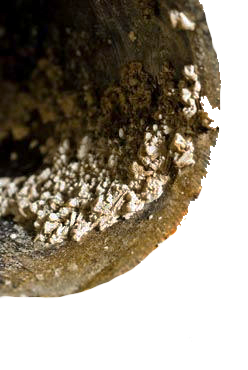PRI-DE™ Wastewater Digester Sulfide and Struvite Control
Example 3. Wastewater Digester H2S and struvite control
When applied to primary settled solids (prior to thickening/digestion), the effect of the PRI technology is two-fold:
- 1) To remove dissolved sulfide that either contributes to immediate biogas H2S levels or provides a sink for Fe added subsequently; and
- 2) To remove total sulfide and so ‘free up' the iron bound as FeS. That ‘freed up' Fe is then available to control H2S production and/or struvite scaling within the digester.
 | An unavoidable benefit of controlling struvite scaling is lower biogas H2S levels. Further, the incidence of H2S inhibition within the digestion process is much reduced. With higher H2O2
doses, mercaptan levels may decrease though care must be taken to
ensure that residual D.O. does not carry-over into the anaerobic
digesters. |
Example 4. Phosphorus binding into dewatering cakes
When applied to digester effluent prior to dewatering, PRI-Tech frees up Fe2+ from FeS (and oxidizes Fe2+ to Fe3+)
with the effect being to partition more phosphorus into the dewatered
cake. Side benefits include improved dewatering efficiency, reduced
struvite scaling, and enhanced odor control. By capturing more
phosphorus into the solids cake, less is returned to the plant influent
and so plant-wide phosphorus loadings are lowered - in some cases enough
to meet tighter effluent nutrient limits. Phosphorus loadings in
dewatering sidestreams can be several hundred mg/L and comprise 25-50%
of the total plant phosphorus loading.
Back to top
Get More Information
Contact USP Technologies for more information on our products and services: